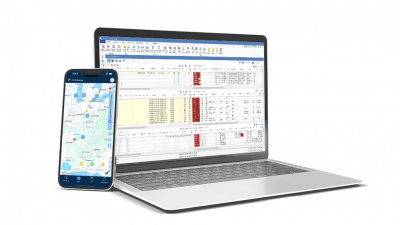When was the last time you manually solved a complex math equation? With calculators and phone apps at our fingertips, it’s probably been a while. Enter the numbers, push a few buttons — and voila! — you immediately have an answer.
For most fleets, load planning is not so simple. Dispatchers still match drivers and loads manually, often by using a planning grid from a dispatch software system. The software lists loads, drivers, equipment, hours-of-service, and other variables but requires humans to solve problems in a linear fashion, one by one.
Unfortunately, linear processes fail to account for dynamic variables that are plentiful in transportation. To cover a load, for instance, a dispatcher may assign the closest driver who is available right now, but fail to notice that another driver is 20 miles closer to the origin and will be available as soon as his hours-of-service rest break ends in under one hour.
You wouldn’t trust napkin math for financial planning, so why trust it for fleet management?
Ready for Prime Time
Manual load planning can be eliminated with an embedded, AI-powered engine that finds the best-possible combination of drivers, tractors, trailers and loads to maximize revenue and minimize cost.
PCS Software now offers a new TMS for Shippers, a transportation management platform (TMP) for fleets with optimization technology to dynamically match drivers, trucks, and loads.
The new TMS for Shippers solves two major fleet challenges from the start:
- Reducing costs lost to empty miles
- Increasing revenue through more efficient load planning
The TMS for Shippers considers every unique variable simultaneously to optimize an entire network in a matter of seconds. Having a system do the heavy lifting makes a big difference in an industry where time is money. Fleet personnel can spend more time dealing with inevitable exceptions that arise during the workday rather than trying to solve complex load planning problems with limited resources.
Solving the Deadhead Dilemma
Running empty represents one of the biggest drains on fleet profitability—especially with diesel prices at historic levels. In a manual operation, the planner looks for an available driver with hours that is close enough to pick up the load. Problem solved but potentially with unnecessary deadhead.
According to the American Transportation Research Institute, deadhead miles represented 33% of all miles traveled for fleets in 2020. Our new TMS for Shippers helps solve this multi-million-dollar dilemma.
Small fleets who plan manually have limited options. They may only need to ask, ‘Do I send truck A or B?’ But as the scope of the operation increases, so does the complexity of the network. Only a technology solution can optimize multiple load assignments in a truly efficient way that fully minimizes empty miles.
Our new TMS for Shippers factors in various data points to find the driver closest to the load without compromising service. The platform analyzes all drivers and equipment both in real time and on the horizon.
The technology finds the closest driver to the load by factoring in distance, hours of service, and delivery times of loads under dispatch. This TMS automation reduces deadhead miles, additional wear and tear on equipment, and wasted driver hours spent moving empty toward a load.
By leveraging the power of artificial intelligence for load planning, motor carriers of all sizes can free up resources to focus on the most critical areas, like customer service and driver relations, and find customers and loads that are more profitable and a better fit for their networks.
Learn more about our new TMS for Shippers and see the system in action. Discover why fleets across the country are saying goodbye to manual load planning.



